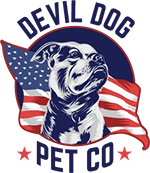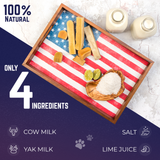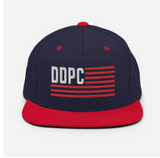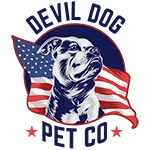Why Getting Your Puppy's Food Right Is Mission-Critical
Listen up-feeding your puppy isn't just about filling a bowl. It's about setting the foundation for 12-15 years of health, energy, and loyalty. Get it wrong in those first crucial months, and you're looking at vet bills that'll make your wallet weep and a dog that never reaches their full potential.
Key Takeaways
- Feeding your puppy properly is essential for their long-term health and energy.
- The first few months of nutrition have a significant impact on your puppy's future well-being.
- Improper feeding can lead to costly veterinary bills.
- Good nutrition helps your puppy reach their full potential.
Table of Contents
- Why Getting Your Puppy's Food Right Is Mission-Critical
- The Non-Negotiable Nutrients Every Puppy Needs
- Why Adult Dog Food Fails Your Growing Pup
- What "Complete and Balanced" Actually Means
- Types of Puppy Food: Your Mission-Critical Options
- Feeding Schedule: Precision Timing for Maximum Growth
- Battle-Tested Brands That Deliver Results
- Making the Switch: From Puppy to Adult Food
- Conquering the Picky Eater: Proven Strategies
- Troubleshooting Common Feeding Problems
- Building Lifelong Healthy Eating Habits
Here's the unfiltered truth: food for puppies isn't the same as adult dog chow. Your growing pup needs nearly twice the protein, specific calcium-to-phosphorus ratios, and calorie density that would make an adult dog pack on dangerous weight. Mess this up, and you're setting your battle buddy up for joint problems, stunted growth, or worse.
When we brought our dog Dexter home, I applied the same attention to detail I learned as a Marine-mission planning, quality control, and zero tolerance for shortcuts. That approach saved us thousands in vet bills and gave us a dog who's thrived for years.
Quick Answer
The best food for puppies must be AAFCO-approved for growth, contain at least 22% protein, and match your pup's breed size. Feed 4 times daily until 12 weeks, then 3 times until 6 months. Choose high-quality brands like Purina Pro Plan, Royal Canin, or Hill's Science Diet, and transition gradually between any food changes over 7-10 days.
The Non-Negotiable Nutrients Every Puppy Needs

Your puppy's nutritional needs aren't suggestions-they're requirements backed by decades of veterinary research. Miss any of these, and you're compromising their development.
Protein: The Building Block Foundation
High quality puppy food must contain at least 22% protein on a dry matter basis-that's nearly double what adult dogs need. But here's what most owners miss: it's not just about quantity, it's about quality.
Look for named muscle meats as the first ingredient: chicken, beef, salmon, or lamb. Avoid generic "meat meal" or "by-product meal"-your pup deserves better than mystery protein. The amino acid profile from quality sources builds strong muscles, supports immune function, and fuels that boundless puppy energy.
Pro Tip: Puppies need approximately 2 grams of protein per pound of body weight daily. A 10-pound pup needs roughly 20 grams of protein-that's about what's in 3 ounces of chicken breast.
Fat: Brain Power and Energy
Puppies need around 8% fat minimum, but many premium formulas run 12-15%. This isn't just for energy-those healthy fats build brain tissue, support vitamin absorption, and keep that puppy coat shiny.
Omega-3 fatty acids from fish oil or flaxseed are particularly crucial during the first year. They support cognitive development and reduce inflammation. Think of fat as premium fuel for your pup's high-performance engine.
Calcium and Phosphorus: The Bone Building Team
Here's where many owners go wrong: they think more calcium equals stronger bones. Wrong. It's about the ratio-1.2:1 calcium to phosphorus is the sweet spot. Too much calcium, especially in large breed puppies, can cause skeletal deformities and joint problems.
Quality puppy kibble gets this balance right. Never supplement with additional calcium unless your vet specifically recommends it. Over-supplementation is one of the fastest ways to create lifelong joint issues.
Critical Fact: Large breed puppies (adult weight over 50 lbs) need controlled calcium levels-typically 1.0-1.8% of their diet. Small breeds can handle slightly higher levels without risk.
Why Adult Dog Food Fails Your Growing Pup
Feeding adult food to a puppy is like sending a Marine to battle with half rations-they might survive, but they won't thrive. The nutritional gap isn't just significant; it's development-threatening.
Adult dog food typically contains 18% protein versus the 22% minimum puppies need. The calorie density is lower, meaning your pup would need to eat massive volumes to meet energy needs-often causing digestive upset and bloating.
More importantly, adult formulas lack the precise nutrient ratios growing dogs require. The calcium-phosphorus balance is wrong, vitamin levels are insufficient, and the kibble size often doesn't match a puppy's smaller mouth and developing teeth.
Puppy-Specific Food Benefits
- 22%+ protein supports rapid growth
- Higher calorie density in smaller portions
- Optimal calcium-phosphorus ratios
- Smaller kibble size for developing mouths
- Enhanced DHA for brain development
Adult Food Limitations
- Insufficient protein for growth demands
- Lower calorie density requires larger portions
- Calcium-phosphorus ratios designed for maintenance
- Kibble size may be too large
- Missing growth-specific nutrients
The bottom line: natural puppy food formulated specifically for growth isn't a marketing gimmick-it's a biological necessity. Your pup's first year determines their lifetime health trajectory. Don't compromise on the foundation.
What "Complete and Balanced" Actually Means

Every bag of high quality dog food for puppies should display an AAFCO statement-that's the Association of American Feed Control Officials. This isn't optional reading; it's your guarantee that the food meets minimum nutritional standards.
Look for this specific phrase: "formulated to meet the nutritional levels established by the AAFCO Dog Food Nutrient Profiles for growth and reproduction." If you see "for all life stages," that works too-it means the food meets the higher puppy requirements.
Avoid foods that only say "for adult maintenance" or have no AAFCO statement at all. These haven't been tested or formulated for growing dogs and can cause serious nutritional deficiencies.
Marine-Level Intel: Some premium brands exceed AAFCO minimums by 20-30%. While not required, this buffer helps ensure your pup gets optimal nutrition even if their appetite varies day to day.
The AAFCO approval process involves either feeding trials with real puppies or laboratory analysis of nutrient content. Feeding trials are the gold standard-they prove dogs actually thrive on the food, not just that it meets theoretical requirements.
Types of Puppy Food: Your Mission-Critical Options
Choosing the right food for puppies isn't about what's trendy-it's about what works. After years of testing different approaches with our dog Dexter and countless conversations with fellow dog owners, here's the tactical breakdown of your main options.
Dry Kibble: The Reliable Workhorse
Dry puppy food remains the gold standard for good reason. It's convenient, cost-effective, and formulated to meet all nutritional requirements in precise ratios. Quality kibble provides consistent nutrition without the guesswork of mixing ingredients.
The key advantage? Shelf stability and portion control. You can measure exact amounts, track calorie intake, and know your pup gets balanced nutrition with every meal. Premium brands like Purina Pro Plan, Royal Canin, and Hill's Science Diet have decades of research backing their formulations.
Transition Timeline: Start with moistened kibble at 6-8 weeks, gradually reducing water over 2-3 weeks until your pup eats it completely dry. This protects developing teeth while building strong chewing habits.
Wet/Canned Food: The Flavor Enhancer
Canned puppy food delivers higher moisture content and intense flavor that picky eaters love. It's particularly useful for puppies transitioning from mother's milk or those recovering from illness.
The downside? Higher cost per calorie, shorter shelf life once opened, and potential for creating finicky eating habits. Many owners use wet food as a kibble topper-mixing 25% wet with 75% dry for the best of both worlds.
Raw and Freeze-Dried: The High-Maintenance Route
Raw diets and freeze-dried options promise "ancestral nutrition," but they require serious commitment and expertise. While some dogs thrive on properly balanced raw diets, the margin for error is slim-especially with growing puppies.
The biggest risks? Nutritional imbalances, bacterial contamination, and incomplete mineral profiles. If you're considering raw, work with a veterinary nutritionist to ensure proper formulation. For most owners, the complexity isn't worth the uncertain benefits.
Kibble Advantages
- Complete nutritional balance guaranteed
- Cost-effective and convenient
- Supports dental health through chewing
- Long shelf life and easy storage
- Precise portion control
Raw Diet Challenges
- Risk of nutritional imbalances
- Bacterial contamination concerns
- Requires extensive knowledge
- Time-intensive preparation
- Higher cost per serving
Feeding Schedule: Precision Timing for Maximum Growth

Your puppy's feeding schedule isn't flexible-it's a carefully orchestrated plan that supports healthy development. Get the timing wrong, and you're looking at house training setbacks, digestive issues, and erratic energy levels.
6-12 Weeks: Four Meals Daily
At this stage, your pup's stomach is tiny but their growth demands are massive. Four evenly spaced meals prevent hypoglycemia (low blood sugar) and support steady development. Feed every 3-4 hours: 7 AM, 11 AM, 3 PM, and 7 PM works for most schedules.
Start with moistened kibble puppy food and gradually reduce water content over 2-3 weeks. This protects developing teeth while encouraging proper chewing habits.
3-6 Months: Three Meals Daily
Your pup's stomach capacity increases, allowing for larger, less frequent meals. Transition to breakfast, lunch, and dinner-typically 7 AM, 12 PM, and 6 PM. This schedule supports house training by creating predictable elimination patterns.
Monitor your pup's energy levels throughout the day. If they're crashing between meals, temporarily return to four smaller portions until their system matures.
6+ Months: Two Meals Daily
Most puppies can handle twice-daily feeding by six months. This adult-like schedule (morning and evening) works well for working owners and supports long-term healthy eating habits.
Large Breed Exception: Dogs expected to weigh over 50 pounds as adults should stay on puppy food until 12-14 months. Their growth plates close later, requiring extended nutritional support.
Calculating Portions: The Math That Matters
Portion control isn't guesswork-it's based on your pup's current weight, target adult weight, and activity level. Most high quality puppy food bags include feeding charts, but these are starting points, not gospel.
A general rule: puppies need roughly twice the calories per pound of body weight compared to adult dogs. A 10-pound puppy needs about 990 calories daily, while a 10-pound adult dog needs only 400 calories.
| Puppy Weight | Daily Calories | Meals Per Day | Calories Per Meal |
|---|---|---|---|
| 5 lbs | 495 | 4 | 124 |
| 10 lbs | 990 | 3-4 | 248-330 |
| 20 lbs | 1,980 | 3 | 660 |
| 40 lbs | 3,960 | 2-3 | 1,320-1,980 |
Adjust portions based on your pup's body condition. You should feel ribs easily but not see them prominently. If your pup is getting chunky, reduce portions by 10-15%. If they're looking thin, increase gradually.
Weight Monitoring: Weigh your puppy weekly during rapid growth phases (8-16 weeks). Sudden weight loss or excessive gain signals the need for immediate portion adjustments.
Battle-Tested Brands That Deliver Results
Not all puppy foods are created equal. After researching nutritional profiles, manufacturing standards, and real-world performance, these brands consistently deliver the quality your growing pup deserves.
Purina Pro Plan Puppy - The Research-Backed Choice
Purina Pro Plan combines decades of nutritional research with real-world feeding trials. Their puppy formulas contain 28% protein, optimal DHA levels for brain development, and live probiotics for digestive health.
The brand offers breed-specific formulas-small breed, large breed, and sensitive stomach options. Their manufacturing standards include rigorous quality control and ingredient traceability that many premium brands can't match.
Royal Canin Puppy - Precision Nutrition
Royal Canin takes a scientific approach to puppy nutrition, with formulas tailored to specific breed sizes and even individual breeds. Their kibble shapes are designed for each dog's mouth structure and eating style.
The nutritional profiles are precisely calibrated for growth phases, with controlled calcium levels for large breeds and enhanced digestibility for sensitive stomachs. It's more expensive but delivers measurable results.
Hill's Science Diet Puppy - Veterinary Trusted
Hill's Science Diet is the food most veterinarians recommend, and for good reason. Their puppy formulas are backed by clinical nutrition research and feeding trials with real puppies.
The brand focuses on digestibility and nutrient absorption rather than flashy marketing claims. Their natural puppy food options avoid artificial colors and preservatives while maintaining nutritional excellence.
Pro Tip: Stick with one high-quality brand for the first 6-8 months. Constantly switching foods can cause digestive upset and make it harder to identify any food sensitivities.
The bottom line: choose a brand with AAFCO approval, feeding trial data, and a track record of supporting healthy puppy development. Your pup's foundation year is too important for experimentation with unproven foods.
Making the Switch: From Puppy to Adult Food
The transition from puppy food to adult food isn't about hitting a calendar date-it's about recognizing when your dog's growth phase ends and their maintenance phase begins. Get this timing wrong, and you risk nutritional imbalances that can affect your dog's health for years.
Timing the Transition by Breed Size
Small breeds (under 25 pounds) mature faster than their larger counterparts. These pups typically reach adult size by 7-9 months and can transition to adult food around their first birthday. Their rapid metabolism and early maturity mean they need fewer calories per pound sooner.
Large and giant breeds (over 50 pounds) need extended nutritional support. Keep them on high quality puppy food until 12-18 months, depending on their growth rate. Their growth plates don't close until 18-24 months, requiring continued calcium and phosphorus balance.
Growth Plate Reality Check: Switching too early can cause joint problems later. Your vet can X-ray growth plates to confirm closure, but most large breeds need puppy nutrition until at least 12 months.
The 7-Day Transition Protocol
Never switch foods cold turkey. A gradual transition prevents digestive upset and allows your dog's gut bacteria to adapt to new ingredients. Here's the proven method that works:
| Days | Old Food | New Food | Notes |
|---|---|---|---|
| 1-2 | 75% | 25% | Monitor for loose stools |
| 3-4 | 50% | 50% | Energy levels should remain stable |
| 5-6 | 25% | 75% | Watch appetite and bathroom habits |
| 7+ | 0% | 100% | Complete transition |
If your dog shows signs of digestive upset-loose stools, vomiting, or loss of appetite-slow the transition. Return to the previous ratio for 2-3 days before proceeding.
Recalculating Portions for Adult Food
Adult dogs need roughly half the calories per pound compared to puppies. A 50-pound adult dog needs about 1,000-1,200 calories daily, while a 50-pound puppy might need 1,800-2,000 calories.
Start with the feeding guidelines on your chosen adult food, then adjust based on your dog's body condition. Most dogs need 10-15% fewer calories than puppy food recommendations suggest.
Conquering the Picky Eater: Proven Strategies
Picky eating in puppies usually stems from one of three causes: medical issues, learned behavior, or inappropriate food choices. Before assuming your pup is just "fussy," rule out underlying problems with a vet visit.
Medical vs. Behavioral Causes
Sudden appetite changes can signal dental pain, gastrointestinal issues, or other health problems. If your previously good eater becomes picky overnight, schedule a vet examination before trying behavioral modifications.
Behavioral pickiness develops when owners cave to demands. Free-feeding, constant treat offerings, and switching foods at the first sign of hesitation teach puppies that holding out gets better options.
Marine Corps Wisdom: Consistency wins battles. Set meal times, offer food for 20 minutes, then remove the bowl-regardless of how much was eaten. Healthy puppies won't starve themselves.
The Structured Meal Approach
Implement strict meal schedules with no free-feeding. Put the bowl down at designated times, give your pup 20 minutes to eat, then remove it-whether it's empty or full. No snacks, treats, or alternative foods until the next scheduled meal.
This approach typically resolves picky eating within 3-5 days. Most puppies test boundaries initially but quickly learn that meal time means business.
Scheduled Feeding Benefits
- Establishes clear expectations
- Improves house training predictability
- Prevents resource guarding
- Makes appetite changes more noticeable
Free Feeding Problems
- Encourages picky behavior
- Makes house training harder
- Attracts pests and bacteria
- Masks health issues
Safe Flavor Enhancement Techniques
If your pup needs motivation, add small amounts of safe flavor enhancers to their regular kibble puppy food. A tablespoon of low-sodium chicken broth, a teaspoon of plain yogurt, or a few pieces of cooked chicken can make meals more appealing.
Avoid creating dependency by gradually reducing enhancers over 1-2 weeks. The goal is teaching your pup to enjoy their regular food, not creating a gourmet expectation.
Troubleshooting Common Feeding Problems
Even with perfect planning, feeding challenges arise. Here's how to handle the most common issues that can derail your puppy's nutritional progress.
Digestive Upset and Food Sensitivities
Loose stools, vomiting, or excessive gas often indicate food sensitivities or too-rapid dietary changes. The most common culprits are protein sources (chicken, beef), grains, or artificial additives.
For mild digestive upset, try a 12-hour fast (water only), then reintroduce small amounts of bland food-boiled chicken and rice in 1:2 ratio. If symptoms persist beyond 24 hours or worsen, contact your veterinarian immediately.
Red Flag Symptoms: Blood in stool, projectile vomiting, lethargy, or dehydration require immediate veterinary attention. Don't wait to see if symptoms resolve on their own.
Preventing Overeating and Puppy Obesity
Chubby puppies might look cute, but excess weight during growth phases stresses developing joints and can lead to lifelong orthopedic problems. Overweight puppies often become overweight adults with shortened lifespans.
Monitor your pup's body condition weekly. You should feel ribs easily without pressing hard, see a visible waist when viewed from above, and notice an abdominal tuck when viewed from the side.
If your pup is gaining weight too quickly, reduce portions by 10-15% and increase exercise duration. Consult your vet if body condition doesn't improve within 2-3 weeks.
Supplement Safety and Necessity
Quality high quality dog food for puppies provides complete nutrition-additional supplements are usually unnecessary and potentially harmful. Excess calcium can cause skeletal deformities in large breed puppies, while vitamin overdoses can cause toxicity.
The only supplements most puppies need are those prescribed by veterinarians for specific health conditions. Avoid over-the-counter joint supplements, vitamin mixes, or "growth enhancers" unless specifically recommended by your vet.
Building Lifelong Healthy Eating Habits
The feeding habits you establish during puppyhood set the foundation for your dog's entire life. Consistency, quality nutrition, and proper portion control during the first year create a framework for decades of healthy eating.
Your puppy's nutritional foundation directly impacts their adult health, energy levels, and longevity. Dogs fed high-quality diets during growth phases show better joint health, stronger immune systems, and fewer chronic diseases as they age.
Remember: feeding puppies food isn't just about meeting today's nutritional needs-it's about building the metabolic and behavioral patterns that will serve your dog throughout their life. The extra effort you invest now pays dividends in veterinary bills saved, energy maintained, and quality years gained.
Bottom Line: Choose AAFCO-approved puppy food, maintain consistent feeding schedules, monitor growth carefully, and resist the urge to constantly switch foods. Your puppy's future health depends on the nutritional decisions you make today.
The investment in premium natural puppy food and disciplined feeding practices during the first year creates a foundation that supports your dog's health, happiness, and longevity for years to come. That's the kind of extreme ownership that builds unbreakable bonds between dogs and their humans.
For more in-depth information on safe and healthy chews, check out are antlers for dogs a good idea.
For additional veterinary guidelines on puppy nutrition, see nutrition general feeding guidelines for dogs.
For a comprehensive scientific review, refer to this peer-reviewed article on canine nutrition.
Download the FREE 10-Step Dog Prep Guide
**Frequently Asked Questions
What foods are good for puppies?
Good foods for puppies provide balanced nutrition with high-quality protein, essential fats, and vital vitamins and minerals to support rapid growth and development. Look for foods formulated specifically for puppies that include DHA for brain development and calcium for strong bones. Whole food ingredients like real meat, vegetables, and grains (if tolerated) are excellent choices to fuel their energy and immune system.
What should you feed a puppy?
Feed your puppy a diet designed for their life stage-puppy-formulated kibble or fresh food that meets AAFCO standards for growth. These foods provide the right balance of protein, fat, and nutrients to support their developing muscles, organs, and brain. Avoid adult dog food or generic table scraps, as puppies have unique nutritional needs and sensitive digestive systems that require consistent, complete meals.
Which feed is best for puppies?
The best feed for puppies is one labeled for growth and development, featuring a high protein content from quality animal sources and supplemented with DHA and antioxidants. It should be free from fillers, artificial additives, and low-quality byproducts. Choose a reputable brand or recipe that matches your puppy’s breed size and any special health considerations for optimal growth and vitality.
Can my 8 week old puppy eat human food?
At 8 weeks, puppies should primarily eat puppy-formulated food to ensure balanced nutrition and avoid digestive upset. Small amounts of certain human foods like plain cooked eggs or lean meats can be introduced cautiously as treats, but avoid anything toxic or high in fat, salt, or spices. Always consult your vet before adding human food to your puppy’s diet and keep treats under 10% of daily calories.
What is the #1 recommended puppy food?
The top recommended puppy food is one that meets or exceeds AAFCO growth standards, contains high-quality animal protein, and supports developmental needs with added DHA and balanced calcium levels. It should be free from artificial preservatives, fillers, and low-grade ingredients. Ultimately, the best puppy food aligns with your puppy’s specific health, breed size, and activity level, backed by transparent sourcing and veterinary approval.
Can puppies eat scrambled eggs?
Yes, scrambled eggs can be a nutritious, protein-rich treat for puppies when cooked plain without butter, oil, salt, or seasoning. Eggs provide essential amino acids and fatty acids that support growth. Serve them in small amounts occasionally to complement your puppy’s balanced diet, and always watch for any signs of intolerance or allergies.






